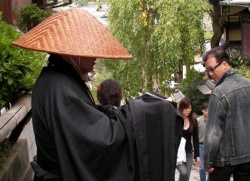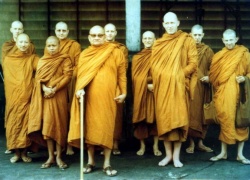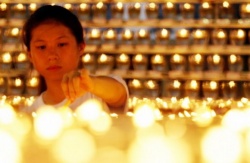The Mystery of Sangha
When we repeat the line sangham saranam gacchami, we are saying ‘to the Sangha for Refuge I go’. For many people, this is the hardest of the Three Refuges to understand. Somehow it makes sense to go for Refuge to the Buddha — the Ideal of Enlightenment, and to the Dharma — the Truth or doctrine, but what does the Sangha mean to us? Who or what, exactly, is it that we go for Refuge to? Although I have been reciting sangham saranam gacchami for over 26 years, I am still fascinated by the ever-unfolding mysteries of sangha.
Of course, I know that technically the words mean that I go for Refuge to the Aryan Sangha, that is, the community of the Wise — those who have gained at least something of the transcendental wisdom of the Buddha. Nevertheless, my strongest personal sense of sangha is reflected in my participation in the spiritual community around me — a community of those who are committed to making the Three Jewels central to their lives.
In 1982 I was living in Stockholm, setting up an FWBO Centre. One day, whilst sitting alone, meditating, I had a vision that has ever since encapsulated for me the meaning of sangha. In this vision, I saw a group of five or six friends sitting in a circle. They were all facing inwards, deep in meditation. Suddenly a column of white light poured down from above, hitting the ground in the centre of the circle. This then spread outwards through those individuals, who suddenly found themselves facing outwards. The white light not only lit up the world around the group of friends, but attracted others to it, so that more and more people joined the circle. After a while, the light beam disappeared, but its luminous effect continued to radiate onwards from all those who joined the circle.
This vision had a profound effect on me. It made me want to devote myself to working with such a group. I too wanted to be a medium through which a higher force could bring light to the world, attracting people to a circle of friends, each of whom would continue to radiate light.
At that time in Stockholm, it wasn’t possible to form a team of Order members and realise my vision in an immediate way. Nonetheless, I did try to develop a sense of spiritual community and friendship, to the best of my ability under the circumstances. For several years my main friend was Kenneth Nolkrantz, who later became Dhirananda, when he joined the Western Buddhist Order. We had initially met when he came to the first talk I gave in Stockholm, and he attended one of the first meditation courses I ran. From the beginning, we felt a mutual liking, which developed over time, and we did our best to create a sense of sangha through our work, communication and practice together. For several years we lived in the same house, occasionally sharing the same room. Although each of us, from time to time, had other areas of work, we did our best to sow the seeds of a new Buddhist movement in Sweden’s capital. Those seeds have sprouted and today there are four Swedish Order members, as well as another Dharmachari from England, running a small but very successful FWBO Centre.
However it wasn’t until 1988, when I moved back to England, that I got an opportunity to participate in a larger team that embodied in a more substantial way what I had seen in my vision. In December of that year I moved to Padmaloka to join a team that Subhuti was forming to run the men’s ordination process. This gave Subhuti and I the precious opportunity to build on a friendship that had been developing for many years.
Looking back, it is difficult to say when Subhuti and I had first become close friends. One early memory I have is of helping him make habitable a small room (in the shell of the building that later became Vajraloka) for a solitary retreat he did back in 1976. At that time he left me a gift of a poem he had written about my name Sona, which means ‘gold’. After I had left for Sweden, our friendship continued, even though we lived in different countries. We always hoped that one day we would live and work together. In 1988 that dream started to come true.
The first few years at Padmaloka were extremely demanding but at the same time wonderfully exciting. They were heady days, full of discussion, study and reflection on what it meant to go for Refuge effectively to the Three Jewels. The task of assessing the depth of other people’s going for Refuge constantly called into question our own, obliging us to look critically at our personal practice of ethics, meditation, spiritual friendship, and so on. This forced us to become very aware of our own failings and shortcomings, but also our strengths and the wonderful power of the Dharma to transform people’s lives.
Subhuti and I lived in a caravan at that time, sharing a space within which it was impossible not to know what the other was doing, and even thinking. We were both excited about spiritual friendship and as time went on we tried to deepen our commitment to each other. At one point, we formalised this commitment by making a contract of friendship: we wrote to each other, committing all our personal possessions to one another, undertaking to protect one another’s name and reputation, and offering to take responsibility for each other’s family and friends, should the need arise. I believe I am still a cheque signatory on Subhuti’s bank account and he told to help myself to money should I ever need it. We still feel committed to this contract.
This was one of the most creative periods of my life, a time when I felt not only very supported by my friendship with Subhuti but also spiritually challenged. Although we are very different temperamentally, both of us gained a great deal from that period together.
In addition to the two of us developing a friendship at that time, the eight of us working on the Ordination Team also began to forge the strong mutual bonds that continue between us to this day. The meetings we all held together were both supportive and challenging. There was also a strong element of collective practice in our life together, as (for example) at the time when we all jointly took a precept to stop using harsh speech. Whenever anyone said something that another team member thought harsh, we would consider whether what had been said was contrary to the spirit of the precept. If we felt this was the case, those concerned would recognise their unskilfulness. We were hammering out not only what is meant by ‘effective going for Refuge to the Three Jewels’, but also the meaning of spiritual friendship — what it is to develop a sense of sangha.
Sometimes we were stretched to the limits, trying to shift what felt like a mountain of work we had created for ourselves. Indeed, the experience forced us to discover our limits and to try to go beyond them, becoming more than what we were. Always, the theme of friendship was never far from our thoughts and discussions with one another. The men who came to Padmaloka to attend the Going for Refuge’ Retreats became aware of the spirit of harmony and kindness that pervaded the retreat centre. To this day, the atmosphere of Padmaloka breathes a fragrance of affection and trust. Although several of us from the original community have moved on, Padmaloka has gradually expanded to include 20 men, all of whom try to live in harmony through following the ideals of spiritual friendship. They believe this to be of paramount importance not only for their own spiritual welfare but also for that of all the men who come there on their journey into the Order.
Today, Subhuti and I once again find ourselves living together in a community, this time as part of the Preceptor’s College, here at Madhyamaloka in Birmingham. We no longer share a caravan, but we do have adjacent rooms, facing each other across the landing. When neither of us is away travelling, and we are home in the community, we try to have some time together each day, spending just under an hour with one another around breakfast-time. We talk about our experiences of the previous day and even our dreams. We also confess any breaches of the preceptsk about how we are working on our mental states, discuss aspects of the Dharma and (especially) tell each other about our meditation practice. These meetings are a high point of the day and I miss them whenever Subhuti is away. In addition, several times each week, I find myself in various meetings with Subhuti, usually with some other senior Order members. Once more, we are forming teams to help with the running of the FWBO, and there is a strong sense of harmony and friendship between us all, as we create sangha together.
Subhuti and I are also part of the College of Public Preceptors. There are now eight of us, five men and three women. This has become the most supportive and inspiring team I have so far experienced in my life. Each of us holds weighty responsibilities, which create various tensions, strains and challenges for each of us. Once again, the very tension we each feel and the commitment we have towards one another give birth to a stronger sense of belonging to something much more than a group. There is, at least for me, a sense that a light is shining through our collective activity. It is, I hope, a light that illumines others and attracts them to the new Buddhist Movement we are establishing — attracts them to the magic and mystery of sangha and Enlightenment.
Sona is now a member of Breath Works mindfulness strategies for living well, pain management and stress reduction, based in Manchester.
Originally published in Madhyamavani: Issue 4 Spring 2001 (Birmingham: Madhyamaloka, 2001).



